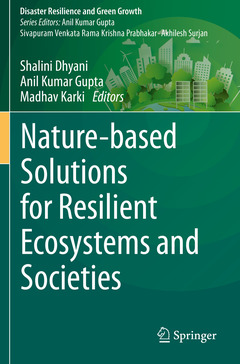Description
Nature-based Solutions for Resilient Ecosystems and Societies, 1st ed. 2020
Disaster Resilience and Green Growth Series
Coordinators: Dhyani Shalini, Gupta Anil Kumar, Karki Madhav
Language: English
Subject for Nature-based Solutions for Resilient Ecosystems and...:
Publication date: 07-2021
455 p. · 15.5x23.5 cm · Paperback
Publication date: 07-2020
Support: Print on demand
Description
/li>Contents
/li>Biography
/li>Comment
/li>
Dr. Shalini Dhyani is a Senior Scientist with the Critical Zone Group, Water Technology and Management Division of the CSIR-NEERI, India. She is the S. Asia Regional Chair for the IUCN Commission on Ecosystems Management (CEM) and Lead Author of the Global Assessment on Sustainable use of Wild Species (2018-2021) by Intergovernmental Science-Policy Platform for Biodiversity and Ecosystem Services (IPBES). Dr. Shalini has been working tirelessly to integrate and mainstream biodiversity and Nature-based Solutions in decision-making and policy planning.
Dr. Anil Kumar Gupta is a Professor and Head of the Environment, Climate and Disaster Risk Management Division and International Cooperation at the National Disaster Management Institute based in New Delhi. Dr. Gupta is known for pioneering contributions to climate change adaptation integration, including disaster management, concepts for and promotion of environmental sustainability, and ecosystem-based approaches to resilience and adaptation.
Dr. Madhav Karki is an expert on Natural Resources Management and the Executive Director and founder of the Centre for Green Economy Development, Nepal (CGED-Nepal), as well as an expert member of the Government of Nepal’s Environment Protection Council. He is a member of the Multidisciplinary Expert Panel of the Intergovernmental Science-Policy Platform for Biodiversity and Ecosystem Services (IPBES) and Deputy Chair of the IUCN Commission on Ecosystem Management (CEM).
Introduces readers to the diagnosis and management of ecosystems and disaster risks using Nature-based Solutions
Provides options for mainstreaming disaster risk reduction and climate adaptation by using ecosystem-based approaches and sustainable development tools
Features case studies, illustrations, success stories, upscaling perspectives and lessons learned from communities affected by disaster and climate adaptation at various levels

